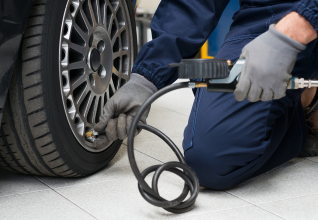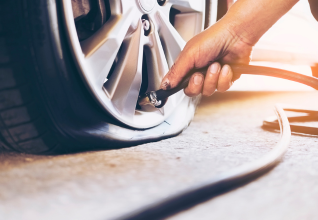If you’ve ever experienced a flat tyre while driving, you understand how important it is to maintain your car tyres. However, underinflated tyres can be just as problematic, leading to increased fuel consumption, reduced tyre life, and poor handling. You can easily avoid these problems by checking your tyre pressure regularly and inflating it to the recommended pressure. This guide will show you how to inflate your car tyres.
How to Put Air in Car Tyres
Before you begin, it’s essential to understand a few things about tyre pressure. Tyre pressure is measured in pounds per square inch (PSI), and every vehicle has a recommended tyre pressure specified by the manufacturer. You can find this information on the driver’s side doorjamb, the owner’s manual, or the tyre itself.
Now let’s dive into the steps on how to put air in car tyres:
Check the current tyre pressure – Use a tyre pressure gauge to check the current pressure in your tyres. Remove the cap from the tyre valve, press the gauge onto the valve stem, and take a reading. Compare the reading to the recommended pressure specified by the manufacturer.

Inflate the tyre – If the pressure is below the recommended level, you’ll need to inflate the tyre. Locate a nearby petrol station with an air pump, park your car close to the air pump, and turn off the engine. Remove the valve cap, attach the air pump nozzle to the valve stem, and turn on the pump. Inflate the tyre in short bursts, checking the pressure after each burst until you reach the recommended level.
Check the pressure again – Once you’ve inflated the tyre, use the tyre pressure gauge to check the pressure again. If the pressure is too high, use the air release valve on the pump nozzle to release some air.
Repeat the process – Repeat steps 2 and 3 for each tyre until all of them are inflated to the recommended pressure.
Tips for Putting Air in Car Tyres
-
Check tyre pressure regularly – We recommend checking tyre pressure at least once a month, especially during temperature changes.
-
Inflate tyres when they’re cold – It’s best to check and inflate your tyres when they’re cold. Driving heats up tyres, which can cause the air pressure to expand and give an inaccurate reading.
-
Don’t overinflate – Overinflated tyres can be just as problematic as underinflated tyres. Always follow the recommended tyre pressure specified by the manufacturer.
-
Invest in a quality tyre pressure gauge – A good tyre pressure gauge will give you accurate readings and last longer.
FAQs
Can I check my tyre pressure at a petrol station?
Yes, most petrol stations have air pumps with pressure gauges that you can use to check and inflate your tyres.
What is the recommended tyre pressure for my car?
Recommended tyre pressures depend on the make and model of your vehicle. This information can be found on the driver’s side door jamb, the owner’s manual, or the tyre itself.
What happens if I don’t inflate my tyres to the recommended pressure?
Underinflated tyres can decrease fuel efficiency, reduce tyre life, and increase the risk of a flat tyre.
Can I drive my car after inflating the tyres?
Yes, you can drive your car immediately after inflating the tyres. Check the pressure again after a few days to ensure they’re still properly inflated.
What should I do if I overinflate my tyres?
Use the air release valve on the pump nozzle to release some air until you reach the recommended pressure.
Wrapping Up
Putting air in car tyres may seem simple, but it’s essential to do it correctly to ensure your tyres are properly inflated. Following the steps outlined in this guide and regularly checking your tyre pressure can improve fuel efficiency, extend tyre life, and ensure safe driving. Don’t forget to invest in a quality tyre pressure gauge and always follow the recommended tyre pressure specified by the manufacturer.
Now that you know how to put air in car tyres, it’s time to start! Remember, proper tyre maintenance is crucial for your safety and vehicle longevity. So, take a few minutes each month to check and inflate your tyres to the recommended pressure, and you’ll enjoy a smooth and safe driving experience.

